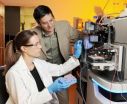Active compounds against Alzheimer's disease: New insights thanks to simulations
2012-01-13
(Press-News.org) More than half of all cases of dementia in the elderly can be attributed to Alzheimer's disease. Despite vast research efforts, an effective therapy has not been developed, and treatment consists of dealing with the symptoms. Changes in brain tissues are a hallmark of Alzheimer's. In affected individuals, small protein fragments known as amyloid beta peptides accumulate and are deposited in the gray brain matter. Researchers recently identified a series of synthetic compounds (inhibitors) that interfere with the self-assembly of the amyloid beta peptide in vitro; they influence both early stages and the transition to the characteristic amyloid fibrils. On a theoretical level, these compounds thus satisfy an initial condition for the development of an Alzheimer drug.
Peptide's disorder determines interaction
In order to understand the interactions between the amyloid beta peptide and active compounds at a structural level, Marino Convertino, Andreas Vitalis, and Amedeo Caflisch from the University of Zurich's Department of Biochemistry simulated these interactions on the computer. In doing so, they focused on a fragment of the peptide that is thought to control both interactions with inhibitors and progression of disease. Based on these simulations, the biochemists were able to identify a hierarchy of interaction patterns between the peptide and various active compounds. To their surprise, they discovered that the disordered structure of the peptide controls the interactions. "The peptide's disorder and flexibility enable it to adapt to many basic structural frameworks," explains Andreas Vitalis. Often it is only subparts of the molecules that mediate interactions on the compound side. However, even minimal changes to a compound may induce measurable changes to the peptide-compound interactions. "Design of active compounds that influence the amyloid beta peptide structurally in a specific manner will only be possible with the aid of high-resolution methods that are limited to one or a few molecules," concludes Vitalis. In the next step, the researchers from the University of Zurich want to identify new classes of active substances with controllable properties that interact with the amyloid beta peptide.
INFORMATION:
Further reading:
Marino Convertino, Andreas Vialis, Amadeo Caflisch. Disordered Binding of Small Molecules to Aβ(12-28). Journal of Biological Chemistry. October 3, 2011. doi: 10.1074/jbc.M111.285957
The study was funded by the Swiss National Science Foundation and University of Zurich research credit.
Contact:
Dr. Andreas Vitalis
Department of Biochemistry
University of Zurich
Tel.: +41 44 635 55 97
Email: a.vitalis@bioc.uzh.ch
END
ELSE PRESS RELEASES FROM THIS DATE:
2012-01-13
PASADENA, Calif.—Astronomers from the California Institute of Technology (Caltech) and the University of Arizona have released the largest data set ever collected that documents the brightening and dimming of stars and other celestial objects—two hundred million in total.
The night sky is filled with objects like asteroids that dash across the sky and others—like exploding stars and variable stars—that flash, dim, and brighten. Studying such phenomena can help astronomers better understand the evolution of stars, massive black holes in the centers of galaxies, and the ...
2012-01-13
PASADENA, Calif. -- A team of researchers at the California Institute of Technology (Caltech) has devised a new method for making complex molecules. The reaction they have come up with should enable chemists to synthesize new varieties of a whole subclass of organic compounds called nitrogen-containing heterocycles, thus opening up new avenues for the development of novel pharmaceuticals and natural products ranging from chemotherapeutic compounds to bioactive plant materials such as morphine.
The team—led by Brian Stoltz, the Ethel Wilson Bowles and Robert Bowles Professor ...
2012-01-13
SAN DIEGO – (January 12, 2012) Researchers at the La Jolla Institute for Allergy & Immunology have proven – for the first time in human tissues -- the specific immune system T cells which trigger the destruction of type 1 diabetes in the pancreas. The finding is an important advance that verifies in humans several important disease characteristics shown in mouse studies and provides a key focal point for interrupting the disease process.
"This study marks the first time that the presence of beta cell-reactive T cells has been directly proven in pancreas tissues from ...
2012-01-13
EVANSTON, Ill. --- By putting 18 million cracks in the proverbial glass ceiling, Hillary Clinton changed the way Americans think about women in politics, and new Northwestern University research suggests that an affirmative action law in India is doing the same for Indian women.
The research, to be published Jan. 12 in the journal Science, focused on the long-term outcomes of a law that reserved leadership positions for women in randomly selected village councils in India.
The law has led to a direct role model effect and is changing the way the girls as well as their ...
2012-01-13
No less than one third of a car's fuel consumption is spent in overcoming friction, and this friction loss has a direct impact on both fuel consumption and emissions. However, new technology can reduce friction by anything from 10% to 80% in various components of a car, according to a joint study by VTT Technical Research Centre of Finland and Argonne National Laboratory (ANL) in USA. It should thus be possible to reduce car's fuel consumption and emissions by 18% within the next 5 to 10 years and up to 61% within 15 to 25 years.
There are 612 million cars in the world ...
2012-01-13
Mothers who take anti-depressants during pregnancy are more likely to give birth to children with persistent pulmonary hypertension (high blood pressure in the lungs) finds a study published today on bmj.com.
Persistent pulmonary hypertension is an increase in blood pressure in the lungs leading to shortness of breath and difficulty breathing. It is a rare, but severe disease with strong links to heart failure.
The study, carried out by researchers at the Centre for Pharmacoepidemiology at Karolinska Institutet in Stockholm Sweden, reviewed 1.6 million births in total ...
2012-01-13
It is time to leave apart the belief that mass media are always a source of bad habits. Television, newspaper and the Internet, when used to get information, may turn out to be of help for health.
It is the conclusion of a study conducted by the Research Laboratories at the Fondazione di Ricerca e Cura "Giovanni Paolo II" in Campobasso which analyzed data from a sample of more than 1,000 people from the largest Moli-sani Project, the epidemiological study that recruited 25,000 subjects in Molise, a southern region of Italy.
The report, published on line in the International ...
2012-01-13
Researchers from the Georgia Institute of Technology and the Centers for Disease Control and Prevention (CDC) have developed a new laboratory test that can rapidly identify the bacterium responsible for staph infections. This new test takes advantage of unique isotopic labeling combined with specific bacteriophage amplification to rapidly identify Staphylococcus aureus.
Quickly and accurately detecting infections caused by S. aureus is critical because the pathogenic bacterium causes a broad spectrum of infections, ranging from acute to chronic disease, which need to ...
2012-01-13
Physicists at Linköping University have shown that a dose of hydrogen or helium can render the "super material" graphene even more useful.
Graphene has engendered high expectations whereof its extreme properties depend on the fact that it consists of a single sheet of carbon atoms. However the attraction forces between the atoms cause the sheets to be drawn to each other. One solution is to add atomic hydrogen between the layers.
Presented in the eminent journal Physical Review A, the researchers' calculations show that the hydrogen at a given concentration affects ...
2012-01-13
Thousands more American senior citizens with kidney disease are good candidates for transplants and could get them if physicians would get past outdated medical biases and put them on transplant waiting lists, according to a new study by Johns Hopkins researchers.
The Hopkins investigators estimate that between 1999 and 2006, roughly 9,000 adults over 65 would have been "excellent" transplant candidates and approximately 40,000 more older adults would have been "good" candidates for new kidneys. None, however, were given the chance.
"Doctors routinely believe and tell ...
LAST 30 PRESS RELEASES:
[Press-News.org] Active compounds against Alzheimer's disease: New insights thanks to simulations


